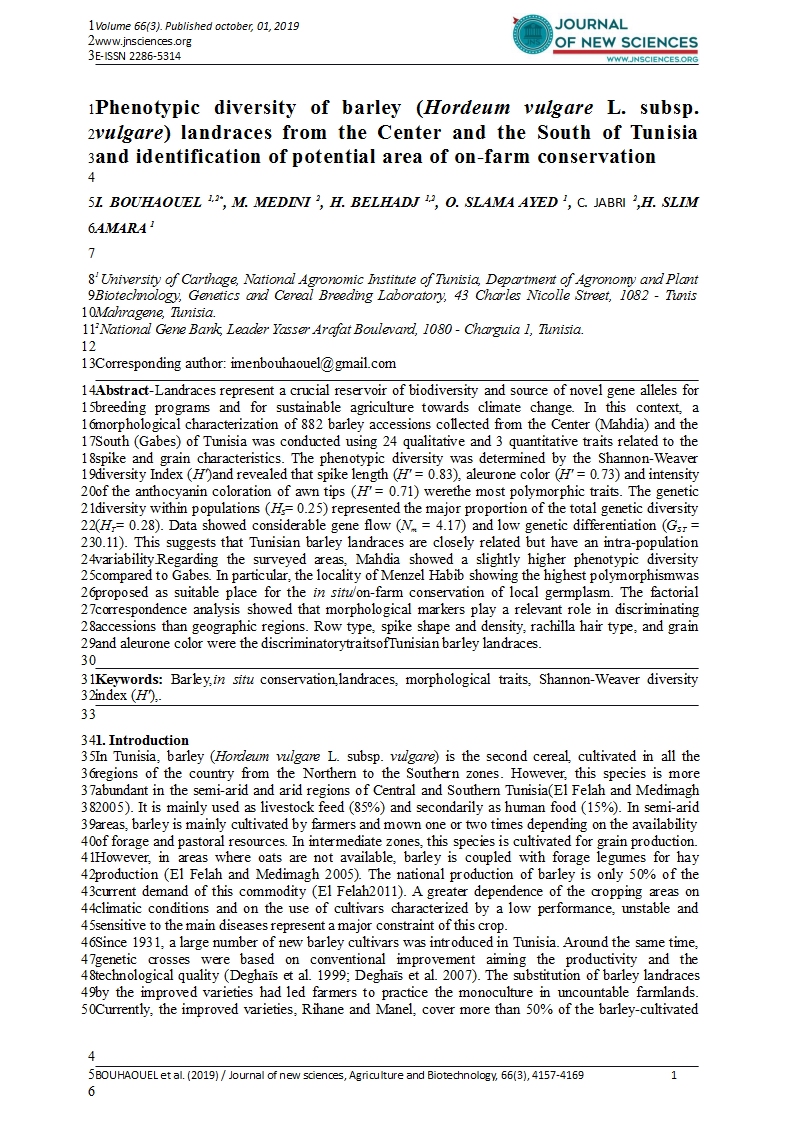

- Category: Volume 66
- Hits: 6645
Phenotypic diversity of barley (Hordeum vulgare L. subsp. vulgare) landraces from the Center and the South of Tunisia and identification of potential area of on-farm conservation
I. BOUHAOUEL 1,2*
M. MEDINI 2
H. BELHADJ 1,2
O. SLAMA AYED 1
C. JABRI 2
H. SLIM AMARA 1
1University of Carthage, National Agronomic Institute of Tunisia, Department of Agronomy and Plant Biotechnology, Genetics and Cereal Breeding Laboratory, 43 Charles Nicolle Street, 1082 - Tunis Mahragene, Tunisia.
2National Gene Bank, Leader Yasser Arafat Boulevard, 1080 - Charguia 1, Tunisia.
Abstract-Landraces represent a crucial reservoir of biodiversity and source of novel gene alleles for breeding programs and for sustainable agriculture towards climate change. In this context, a morphological characterization of 882 barley accessions collected from the Center (Mahdia) and the South (Gabes) of Tunisia was conducted using 24 qualitative and 3 quantitative traits related to the spike and grain characteristics. The phenotypic diversity was determined by the Shannon-Weaver diversity Index (H')and revealed that spike length (H′ = 0.83), aleurone color (H′ = 0.73) and intensity of the anthocyanin coloration of awn tips (H′ = 0.71) werethe most polymorphic traits. The genetic diversity within populations (HS= 0.25) represented the major proportion of the total genetic diversity (HT= 0.28). Data showed considerable gene flow (Nm = 4.17) and low genetic differentiation (GST = 0.11). This suggests that Tunisian barley landraces are closely related but have an intra-population variability.Regarding the surveyed areas, Mahdia showed a slightly higher phenotypic diversity compared to Gabes. In particular, the locality of Menzel Habib showing the highest polymorphismwas proposed as suitable place for the in situ/on-farm conservation of local germplasm. The factorial correspondence analysis showed that morphological markers play a relevant role in discriminating accessions than geographic regions. Row type, spike shape and density, rachilla hair type, and grain and aleurone color were the discriminatorytraitsofTunisian barley landraces.
Keywords: Barley,in situ conservation,landraces, morphological traits, Shannon-Weaver diversity index (H′)

